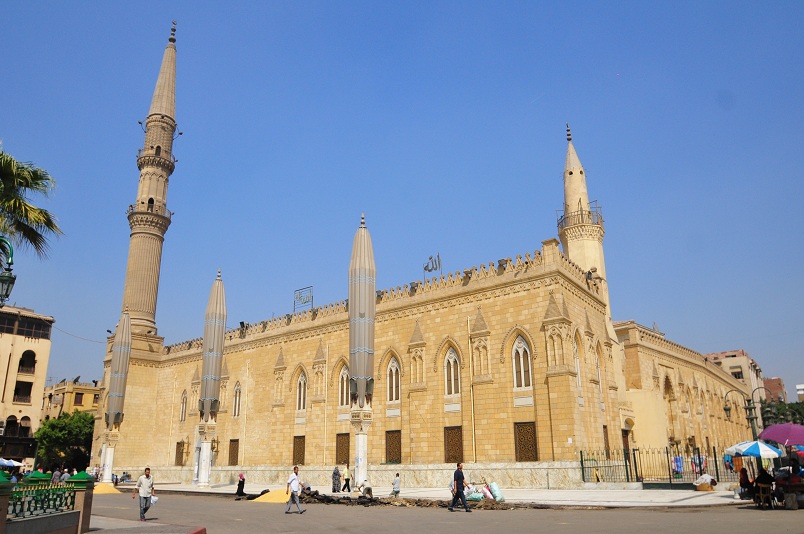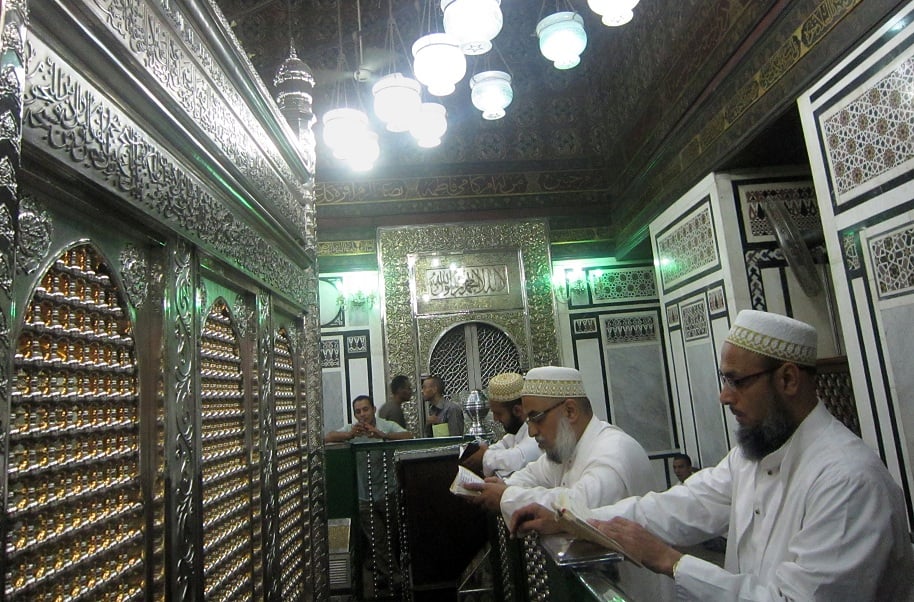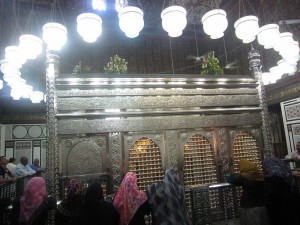
Hassan Ibrahim
Shi’ia Islam in Egypt:
Going to Sayedna Al-Hussein Mosque, you need to prepare yourself for a spiritual journey. It is the mosque where the noble head of the prophet’s grandson is said to be buried.
Although narratives differ on what is really inside the mausoleum, whether it is Al-Hussein’s noble head or some of his blood in a wooden box, no one would belittle the holiness and the sacredness of the place.
Stepping in through the wooden gates, the smell of musk fills my nostrils. The mausoleum is surrounded by a silver mashrabeya (a window made typically out of interlacing strips of wood). The square around the mausoleum is divided with a silver bar, the first half reserved for men while the other is for women. In both divisions you will find prayer corners decorated with Quranic verses carved in wood and marble.
Greenish and white bulbs hang down from the ceiling of the titanic dome, to illuminate the mausoleum and the prayer corners around it. Whatever my eyes fall upon, I see variations of the five-pointed Islamic star that stands for the five pillars of Islam.
In the men’s section, men in white kaftans and white embellished takiyas (short rounded hats) quietly recite the Quran and kiss the different sides of the mashrabeya, showing their love and respect.
Similarly, the mausoleum of Essayeda Zeinab is covered with a silver and brass mashrabiya, but on a smaller scale. The prayer area is filled with seemingly non-Egyptian women in colorful veils reciting du’aa (prayer) for the imam Ali’s daughter. The women shed tears and pray that Allah protect their loved ones.
These two mausoleums were of vital importance in Egypt’s history. Egyptians related to them when the Fatimid Caliphate introduced Shi’a Islam.
When the Fatimid Caliphate started in Egypt back in 969 CE, Egyptians were adherents to Sunni Islam. The Fatimids were followers of Ismali Shi’a Islam, so slowly but peacefully they succeeded in converting Egypt to Shi’a Islam for two centuries.
They launched one of the biggest scientific movements and established Al-Azhar (originally as a Shi’a university) to teach people about Shi’a Islam. When Salah El-Din became the sultan of Egypt, he converted the country back Sunni Islam.
Ever since then, the Egyptian Shi’a population has kept diminishing.
Today, there is no official number for Shi’as, not even one from an old census of Egypt’s population. The Egyptian Shi’as spokesperson Bahaa Anwar, chairman of the Centre of Fatimid Egypt for Human Rights, stated that the number of Egyptian Shi’as could reach up to 3 million. Media estimates place the figure between 50,000 and 80,000, while another approximates 700,000.
A Persecuted Community?

Sarah El Masry
“I don’t want to save the Bahraini people,” said a passerby.
“Why?” said the young man disseminating flyers on one of the corners of Talaat Harb Square in downtown Cairo.
“They are Shi’as,” replied the man.
The young man was flabbergasted. “Aren’t they humans after all? And what about their rights?” he said.
The passerby said, “no, they are not and you seem to be a Shi’a.”
“Yes, I am,” said the young man.
This was the end of the dialogue and shortly the young man, Amr Abdullah, was beaten up by a group of people including the man he was conversing with.
“Save Bahraini People,” was the title of the flyers Abdullah distributed.
“I was just calling for a march in support of the Bahraini protests, I did support all protests in the Arab spring countries, but the world is silent about Bahrain… I did not call for Shi’a Islam, but I was beaten up because I disclosed my religious identity.
“It is not normal to get beaten up if you said your religious identity in a street in the heart of the city where culture thrives. I did not even get into a discussion or a debate,” said Abdullah.
24 year old Abdullah was not born to a Shi’a family, in fact he is the only member in his family who converted, the rest of his family remained Sunni.
“I embraced Shi’a Islam at the age of 16. Back then I had never known any Shi’as, but I used to read a lot and that’s how I found my way,” he said. His family tried to convince him to go back on his decision, but they accepted his choice in the end.
Being beaten up is not the only sectarian incident Abdullah under went experienced. The second was with a Salafi sheikh who threatened to kill him after they appeared together on a TV talk show. The sheikh followed his posts and shared a photo of him on Facebook, with a caption that invited people to hand Abdullah over to the police. Later on, the sheikh rallied his followers to a police station where he filed a police report charging Abdullah with contempt of religion.
“The charge was based on a Facebook post where I insulted some of the Sahabah (Prophet Muhammad’s companions),” Abdullah said.
Abdullah believes that before the revolution, the persecution was by the state security.
“After the revolution, there is an inclination to legalise persecution against Shi’as and the case of Skheikh Asfour is the proof,” he said.
Sheikh Asfour is an Azhar sheikh who was sentenced in july to one year in prison with a fine of EGP 100,000. His charges were contempt of religion and desecration of mosques in his area.
Abdullah said with a nervous voice, “the case of Sheikh Mohamed Asfour is unprecedented… before we did not have a law against Shi’a Islam, now the state is fighting Shi’a Islam.”
A new constitution, a recurring plight
Abdullah story is not unique to him. Other Egyptian Shi’as have experienced similar harassments. Even Anwar sought asylum in Turkey at one point.
“The state security harassed then detained me for a week. Consequently, I had to leave the country and I sought asylum in Turkey… I stayed there for eight months.”
When Anwar came back to Egypt he was detained again, but this did not stop him from advocating Shi’a rights. He presented the Shi’as social and political demands to the (now dissolved) parliament as well as the Supreme Council of Armed Forces and he met with officials of the Muslim Brotherhood such as Mohamed El-Beltagy.
He listed his demands.
“We demanded to be represented in the Constituent Assembly or at least to be invited to the public hearing sessions, to appoint Shi’a representatives in the upcoming parliament just like how the state appoints Copt representatives, to acknowledge Shi’a Islam as a branch of Islam under which people can worship and practice their rituals, and to allowing the building of husseiniyat(Shi’a houses of worship).

Sarah El Masry
“Shi’as were forced to leave their jobs and their houses and used to be attacked. That’s why we want to be protected.”
El-Taher El-Hashemi, the vice president of the Tahrir party (often dubbed the Shi’a party) believes that Shi’as are just like the rest of Egyptians. They have rights to attain and duties to fulfill and just like any minority group, they want the new constitution to guarantee them freedom to practice religion and freedom from oppression, and to establish the concept of citizenship.
He said, “the Egyptian society is undergoing a plan to drag it from a society based on the concept of citizenship to sectarianism. Therefore, we’re observing the restraints on some communities such as the Copts and the Bedouins; Egyptian Shi’as are no exception.”
Anwar explained that unless there are some Shi’a representatives in the constituent assembly, minority rights will be at risk. He gave an example of the difference between freedom of creed and freedom to practice religion and rituals. The leaks from the constituent assembly declare that the first is guaranteed while the second will be restricted to the three Abrahamic religions. This should protect Shi’as since they are Muslims, however the reality on the ground is different and complicated.
“On the one hand, the new constitution will supposedly acknowledge the three heavenly religions and guarantee freedom to practice religion, on the other we cannot practice our rituals freely or build our houses of worship,” said Anwar.
Another constitutional controversy related to Shi’as was instigated by Nader Bakar, spokesperson for the Salafi Al-Nour party and a member of the constituent assembly. He suggested drafting an article in the new constitution about penalising anyone who insults or slanders or negatively alludes to the prophet Muhammad, his family, wives or companions.
Abdullah believes that such an article is clearly to antagonise Shi’as, but he mockingly said “what an age are we living in, today the world is a huge and laws can’t prevent ideas from spreading… you challenge ideas with ideas.”
Although these controversies are based on leaks and there are a whole set of problems related to the constituent assembly, they pose many questions on whether the constitution will be drafted in a way that protects Sunni Muslims only.
“There is No Party for Shi’as”
Under the deposed Mubarak, Shi’as were barred from politics. Hence, after the revolution they were eager to enter the political arena.
In October 2011, Dr Ahmed Rasem El-Nafees (a famous Shi’a) presented the official papers to the Political Parties Affairs Committee to establish the Tahrir party. Due to the fact that many Shi’a leaders joined the party, the party was widely considered Shi’a.
The party was initially not authorised because the party did not meet one of the requirements with regards to the number of the members.
“Our party is subject to Egyptian law, according to which no party can be established on a sectarian or ethnic base, and we reject the existence of such a party. The Tahrir party is not a religious party by any means. The party has people from all religious and ideological backgrounds,” said El-Hashemi.

Hassan Ibrahim
He explained that the party is just another part of Egyptian civil society seeking to achieve its political platform on the ground. The party adopts a liberal and civil agenda.
The party appealed to the court after it’s registration was rejected and recently, in September 2012, the court refused its appeal leaving the status of the party unknown. Nevertheless, the party brought the Shi’as into the public eye.
According to Al-Arabiya News, some political figures such as Refaat El-Said, the head of Al-Tagamo’ Party, and commentators such as Fahmy Howeidy raised questions about the risk of establishing parties on the basis of a religious sect and how it could exacerbate polarisation and sectarianism already existent in the Egyptian society. Thus, Shi’as were put on the defensive.
Facing the Tide
When the Shi’as became active after the revolution, entering the political scene using media outlets to demand more rights, everyone was alerted to the precedent this might set.
The alarm calls came one after another. And the visit to Cairo of Lebanese Shi’a cleric Ali al-Korani, in May 2012, incited campaigns against the Shi’as.
During Korani’s visit he inaugurated a husseiniya in 6th of October city. After holding some Shi’a rituals, the husseiniya was reported and police closed it down and confiscated the publications inside. Groups such as the Salafis, and individuals including parliamentarians, claimed the visit was an attempt to spread Shi’a Islam and they demanded that Al-Azhar (the most prestigious Sunni institute in Egypt) intervene.
The Grand Sheikh of Al-Azhar Ahmed Al-Tayeb issued a statement, along with the Islamic Research Academy and the Ministry of Religious Endowments, rejecting the husseiniyat.
Sheikh Mohamed Al-Mokhtar Al-Mahadi, a member of the Council of Senior Azhar Scholars, the Islamic Research Academy and the current Imam of the Gam’iyaShar’iya (an Islamic charity organisation) clarified why Al-Azhar had to respond to the activities of the Shi’as.
He said, “Al-Azhar discerned that there are some elements who seek to spread Shi’ism in Egypt by giving some material inducements to those who did not get proper Islamic education.
These elements exploited the fact that Egyptians love the prophet’s family, restricted the family of the house of the prophet to the imam Ali only, began to humiliate the Sahabah and the Mothers of the Believers [the prophet’s wives], dared to publish articles and go on TV to demean them, particularly the Mother of the Believers Aisha, and undermined their credibility in passing the Sunnah (the prophet’s practices) on to the successive generation.”
The Islamic Research Academy, the Ministry of Religious Endowments and the Gam’iyaShar’iya, then formed a special committee to research the origins of Shi’a Islam in Shi’a authentic documents, in order to refute their allegations and reveal the “true” path of Sunni Islam to Egyptians, who have followed the Sunni doctrine for over a thousand years.
The committee chose to gather the imams and preachers of Al-Azhar, the Ministry of Religious Endowments and the Gam’iya Shar’iya, and give them courses to illustrate the principles of Shi’a Islam and the means Shi’a preachers use to “penetrate the heads of simple Egyptians.”
He emphasised that “the specialty of the committee is first and foremost scientific research, it is not authorised to take legal action of any sort. When we get a query from the judiciary we give our opinion as an advisory board, we are never authorised to issue a verdict.”
Sheikh Al-Mahdi illustrated the differences between the two branches of Islam because he thinks this will help people understand Al-Azhar’s intentions, and that it does not seek to further the distance between the two branches.
He said, “Sunnis and Shi’as have major doctrinal differences and they are not partial like what Shi’as claim. First, Shi’as believe in the concept of ismah (infallibility) of the imam. For the imam to be infallible, it insinuates that his words were according to a revelation and Sunnis believe that the revelation ended with prophet Muhammad’s death. Sunnis believe that there is no ismah after the prophet.
“Second, Shi’as believe in the concept of taqiya, which means concealing their true religious beliefs when dealing with Sunnis. For example, Shi’as admit the Sahabah’s grace, but through their actions they slander them.”
According to Sheikh Al-Mahadi, Shi’as justify the taqiya concept by citing a verse in the Quran which originally targeted pagans. “Shi’as regard us Sunnis as infidels and this second concept stalled all attempts at reconciliation between the two branches.”
Abdullah believes that Al-Azhar is supposed to be a “beacon for moderate Islam.” He thinks Al-Azhar has been infiltrated by the Salafis because of its financial dependency and Salafis feel threatened by Shi’a Islam and its “revolutionary nature” and thus they seek to curb it.
Sheikh Al-Mahdi rebutted this accusation. He said, “everyone knows that Al-Azhar follows the Ash’ari school [an Islamic school that depends on logic and analogy to interpret the Islamic creed]. The Ash’ari school rejects Wahhabism [an Islamic school that follows the literal meaning of the Quran] and vice versa. We do not have any Wahhabi sheikhs in the Islamic research academy.”
Many Shi’as claim that since Al-Azhar teaches the Shi’afiqh (Islamic jurisprudence) then it means it implicitly admits that Shi’a Islam is legitimate. However, Sheikh Al-Mahdi explained that when Sheikh Mohamed Shaltout (an Islamic Scholar and the first grand sheikh of the Azhar) examined Shi’afiqh and the origins derived from it, he concluded that Shi’afiqh can be studied because it is based on the origins of Islam. Nevertheless, Sheikh Shaltout did not refer to slandering the Sahabah or the concepts of ismah or takiya.
Al-Azhar is seeking to challenge the perceived Shi’a tide by pushing its sheikhs and preachers to a better understanding of Shi’a Islam, but the campaign may come at the expense of the concept of citizenship.


